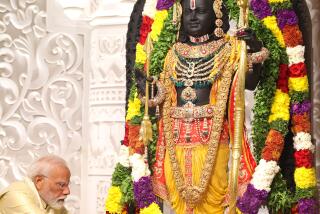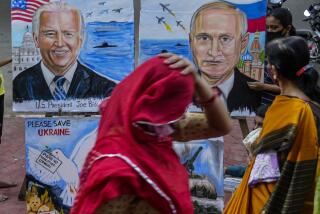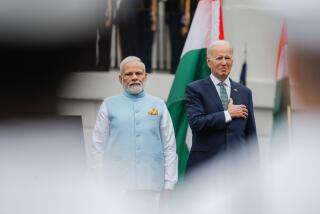India Is a Country Moving Forward
- Share via
President Clinton is on a voyage of discovery to see for himself the success story of the parliamentary democracy in India that has evolved to a point where consensus-building and decision-making have become established norms. This is underpinned by the political arithmetic in government formation where coalitions have now become a rule.
When I was prime minister, my government consisted of 13 parties. The present coalition, headed by Atal Behari Vajpayee, is supported by nearly 23 political parties. Coalition politics engenders a distinct culture of governance, which is intrinsically more stable than a government based on a majority of just one party. It also provides a more participatory relationship, similar to that found in the U.S.
The devolution of authority has led to the empowerment of grass-roots level institutions in villages and towns, which now have more than 3 million elected representatives--1 million of them women. Such a large representation of women in government is unparalleled in the democratic world.
In south India, Clinton saw how the important challenges of development and justice are democratically tackled.
Kerala, a small state in the south of India, has learned that universal literacy, particularly among women, has achieved remarkable results. With 98.5% literacy, the rate of population growth has declined and is now comparable with some of the Scandinavian countries. This non-coercive approach to population control is the first item on the nation’s agenda.
With the rising income and population, India’s energy requirements are growing rapidly. Only one-third of its need can be met internally, making India even more dependent on external supplies. This implies a degree of congruence with the United States and other powers seeking security of the sea lanes and stability in the Gulf and Central Asia.
India’s development needs have led to sweeping economic reforms and an openness to trade and foreign investments that changes the traditional pattern toward foreign involvement. Economic trade with the U.S. is increasing rapidly. It is believed that half of the Fortune 500 companies either are already established in India or are about to set up operations there.
By now, President Clinton and Prime Minister Vajpayee have worked out details of new political and economic equations for a bilateral relationship. They will bid farewell to the Cold War mind-sets and prejudices. Both leaders appreciate that in any multi-faceted relationship between two large democracies, some differences of opinion are bound to be present.
There may be a misperception regarding India’s commitment to disarmament and the Comprehensive Test Ban Treaty. This visit and the series of Indo-U.S. talks have gone a long way to end this discord. India is committed in principle to the CTBT, as well as to the idea of complete elimination of nuclear weapons and creation of a nuclear weapon-free world. However, just as it is imperative for the Clinton administration to secure congressional consensus on the CTBT, in India all shades of political opinion must be satisfied that the signing of the treaty does not, in any way, adversely affect the country’s security. In the meantime, declaring minimal deterrence as its strategy should end any doubts the world has about India’s intentions.
The intensity of any relationship is based on whether the two sides pose a threat to each other or whether they present opportunities. India’s limited nuclear weapons, in a sense like those of Britain, France and Israel, do not pose any threat to the U.S.
India’s steady economic growth is bound to result in closer and multi-faceted relations with the world community. Democracies are more likely to be stable partners, less likely to interfere in each other’s affairs, less likely to make war with each other. As President Clinton would agree, in the post-war era we are dealing with difficult legacies but positive trends. The visit should strengthen this belief.
More to Read
Sign up for Essential California
The most important California stories and recommendations in your inbox every morning.
You may occasionally receive promotional content from the Los Angeles Times.










